Changes in PRIMAP-hist v2.6_final compared to v2.5.1_final for Lithuania
2024-09-24
Johannes Gütschow
Change analysis for Lithuania for PRIMAP-hist v2.6_final compared to v2.5.1_final
Overview over emissions by sector and gas
The following figures show the aggregate national total emissions excluding LULUCF AR6GWP100 for the country reported priority scenario. The dotted linesshow the v2.5.1_final data.
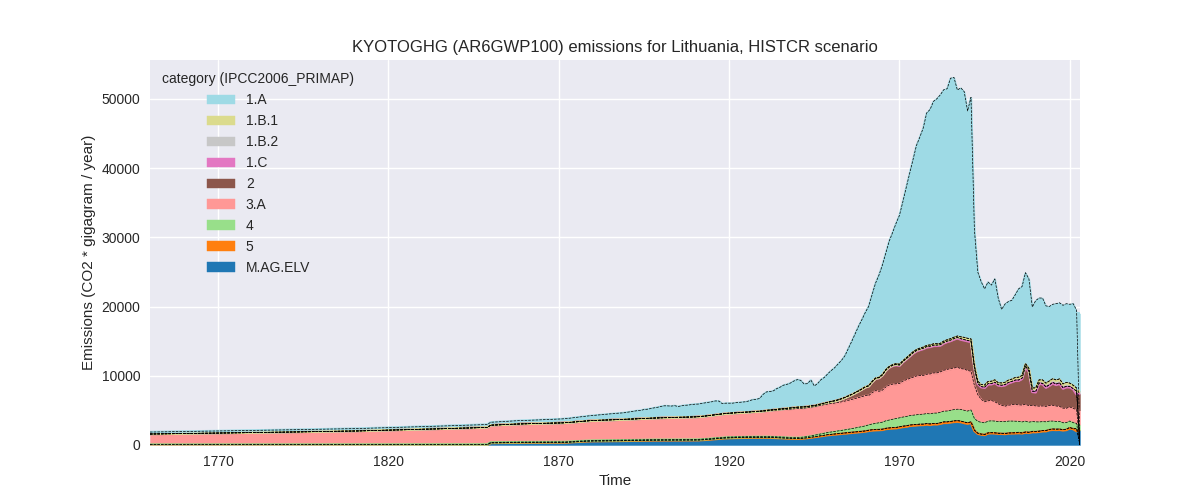
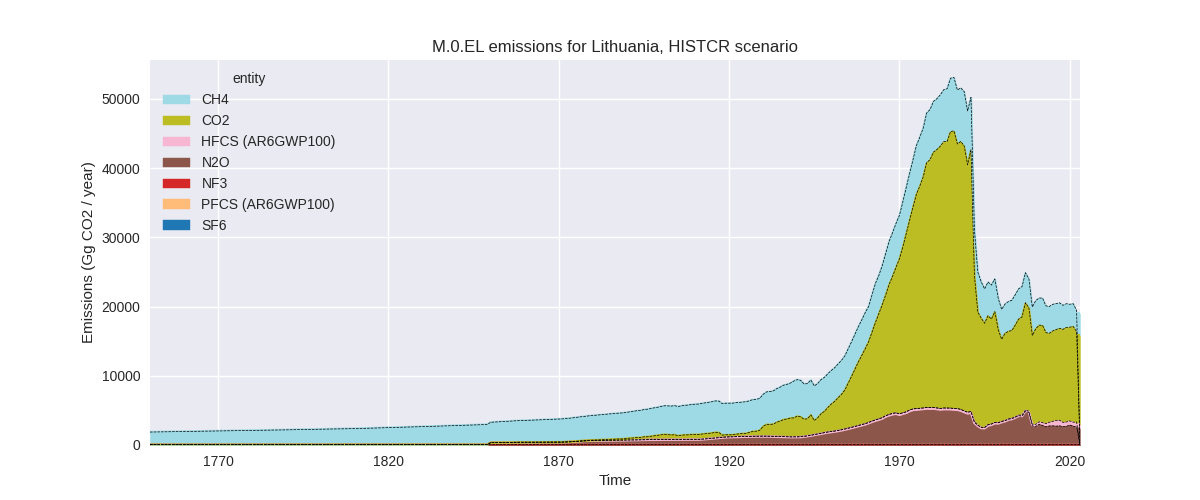
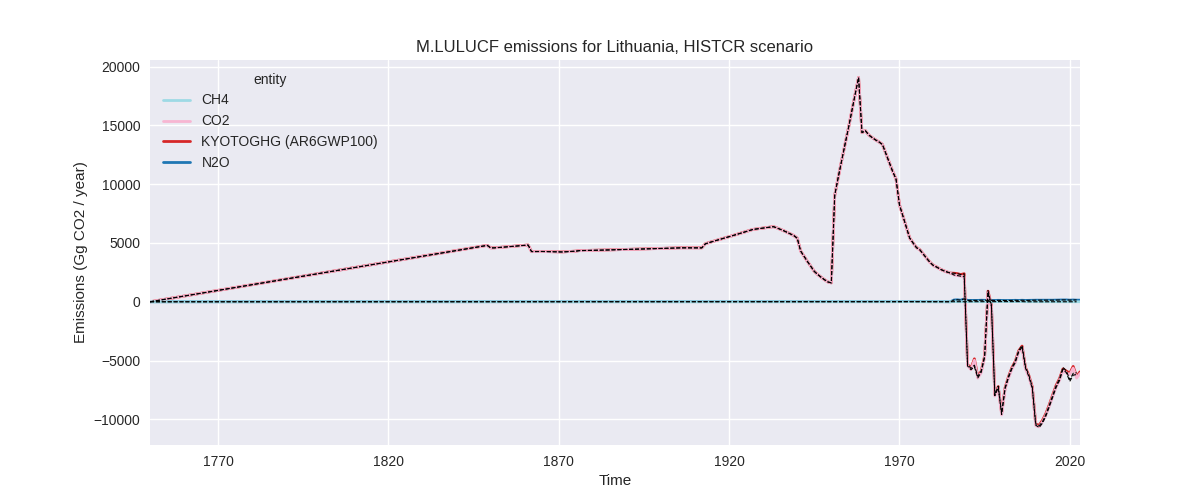
The following figures show the aggregate national total emissions excluding LULUCF AR6GWP100 for the third party priority scenario. The dotted linesshow the v2.5.1_final data.
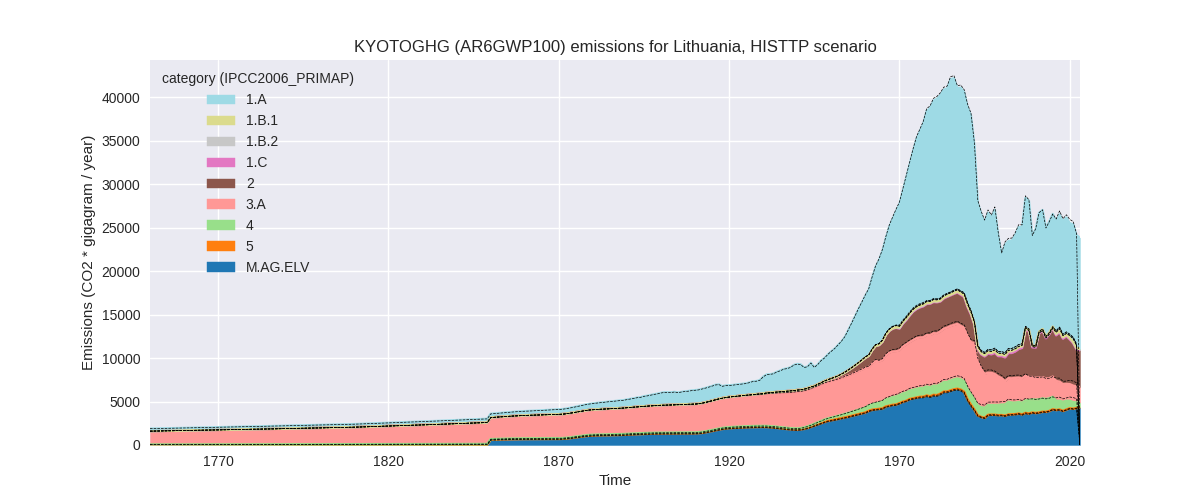
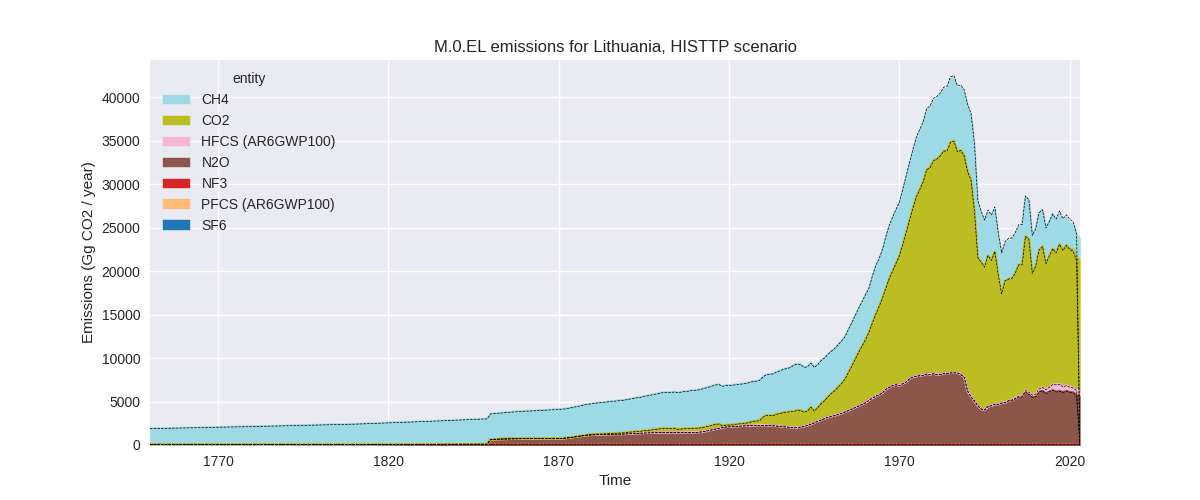
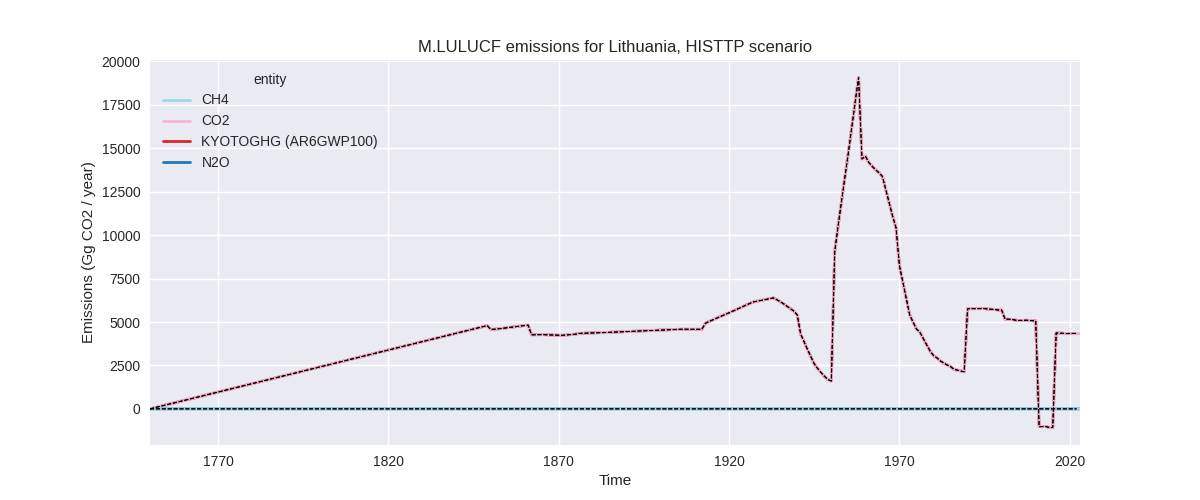
Overview over changes
In the country reported priority scenario we have the following changes for aggregate Kyoto GHG and national total emissions excluding LULUCF (M.0.EL):
- Emissions in 2022 have changed by -2.1%% (-414.15 Gg CO2 / year)
- Emissions in 1990-2022 have changed by -0.5%% (-122.39 Gg CO2 / year)
In the third party priority scenario we have the following changes for aggregate Kyoto GHG and national total emissions excluding LULUCF (M.0.EL):
- Emissions in 2022 have changed by -0.6%% (-153.71 Gg CO2 / year)
- Emissions in 1990-2022 have changed by -0.9%% (-250.15 Gg CO2 / year)
Most important changes per scenario and time frame
In the country reported priority scenario the following sector-gas combinations have the highest absolute impact on national total KyotoGHG (AR6GWP100) emissions in 2022 (top 5):
- 1: M.AG.ELV, N2O with -359.88 Gg CO2 / year (-15.9%)
- 2: 2, CO2 with -268.65 Gg CO2 / year (-14.0%)
- 3: 1.A, CO2 with 123.59 Gg CO2 / year (1.1%)
- 4: 3.A, CH4 with 114.56 Gg CO2 / year (6.0%)
- 5: 4, CH4 with 109.16 Gg CO2 / year (16.1%)
In the country reported priority scenario the following sector-gas combinations have the highest absolute impact on national total KyotoGHG (AR6GWP100) emissions in 1990-2022 (top 5):
- 1: M.AG.ELV, N2O with -92.37 Gg CO2 / year (-4.7%)
- 2: 4, N2O with -42.33 Gg CO2 / year (-71.4%)
- 3: 3.A, CH4 with 18.71 Gg CO2 / year (0.7%)
- 4: 2, CO2 with -8.47 Gg CO2 / year (-0.4%)
- 5: 4, CH4 with 3.31 Gg CO2 / year (0.2%)
In the third party priority scenario the following sector-gas combinations have the highest absolute impact on national total KyotoGHG (AR6GWP100) emissions in 2022 (top 5):
- 1: 4, CH4 with -458.82 Gg CO2 / year (-45.8%)
- 2: 1.A, CO2 with 311.78 Gg CO2 / year (2.5%)
- 3: 2, HFCS (AR6GWP100) with -32.50 Gg CO2 / year (-5.3%)
- 4: 4, N2O with 27.07 Gg CO2 / year (37.6%)
- 5: 2, SF6 with -4.06 Gg CO2 / year (-66.0%)
In the third party priority scenario the following sector-gas combinations have the highest absolute impact on national total KyotoGHG (AR6GWP100) emissions in 1990-2022 (top 5):
- 1: 4, CH4 with -272.51 Gg CO2 / year (-19.1%)
- 2: 1.A, CO2 with 15.51 Gg CO2 / year (0.1%)
- 3: 4, N2O with 4.25 Gg CO2 / year (6.4%)
- 4: 5, N2O with 3.55 Gg CO2 / year (4.3%)
- 5: 2, HFCS (AR6GWP100) with -0.98 Gg CO2 / year (-0.4%)
Notes on data changes
Here we list notes explaining important emissions changes for the country. ’' means that the following text only applies to the TP time series, while means that it only applies to the CR scenario. Otherwise the note applies to both scenarios.
- We have added EEA 2024 inventory data.
- N2O from M.AG.ELV is lower in 2022 due to a decline in emissions in 2022 and cumulatively due to a small reduction of emissions in EEA2024 vs CRF2023 (CR)
- 2022 chemical industry CO2 is lower than in v2.5.1 because EEA shows a strong emissions decline in 2022 which is less pronounced in EDGAR 8.0 (CR)
- CH4 from livestock is higher in 2022 because EEA shows rising emissions while EDGAR 8.0 shows declining emissions for 2022 (CR)
- CH4 from waste is lower in 2022 because EEA shows a smaller emissions decline than EDGAR 8.0 for 2022 (CR)
- Energy CO2 is slightly higher for 2022 because EI2024 and EEA2024 show a smaller emissions decline for 2022 than EI2023 (CR, TP)
- Changes in sectors 4 and 5 are due to the removal of FAOSTAT data (TP).
Changes by sector and gas
For each scenario and time frame the changes are displayed for all individual sectors and all individual gases. In the sector plot we use aggregate Kyoto GHGs in AR6GWP100. In the gas plot we usenational total emissions without LULUCF. ## country reported scenario
2022
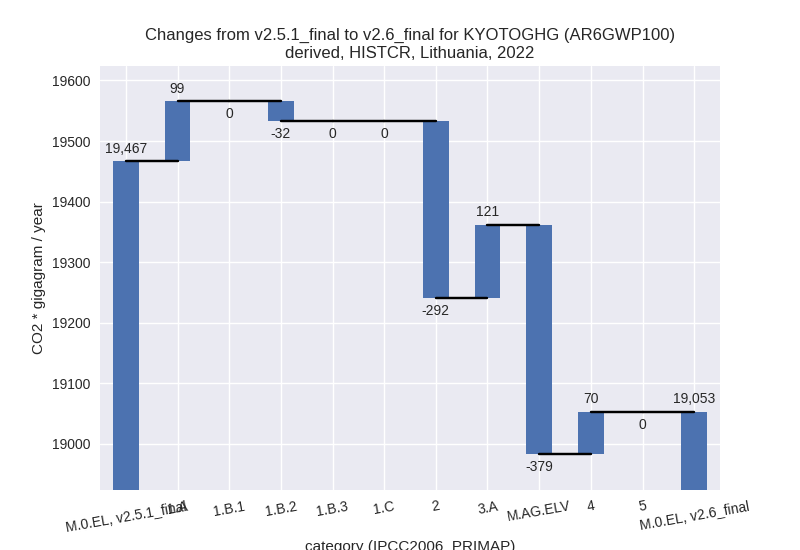
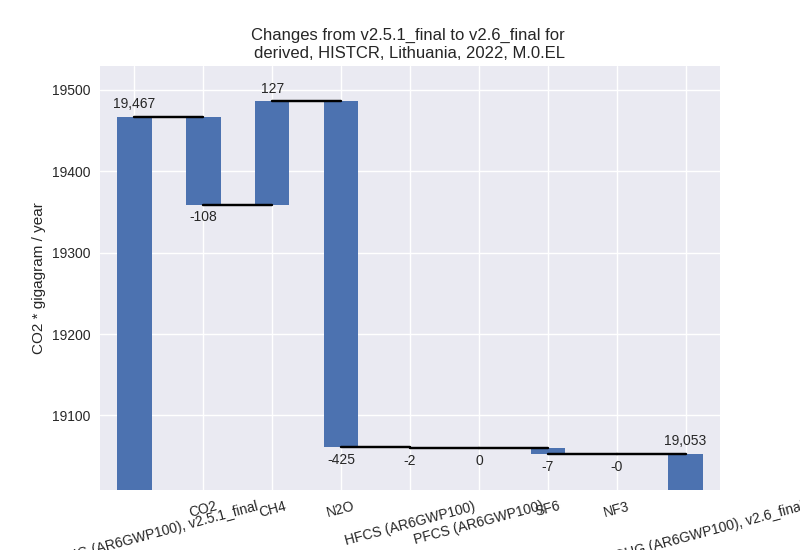
1990-2022
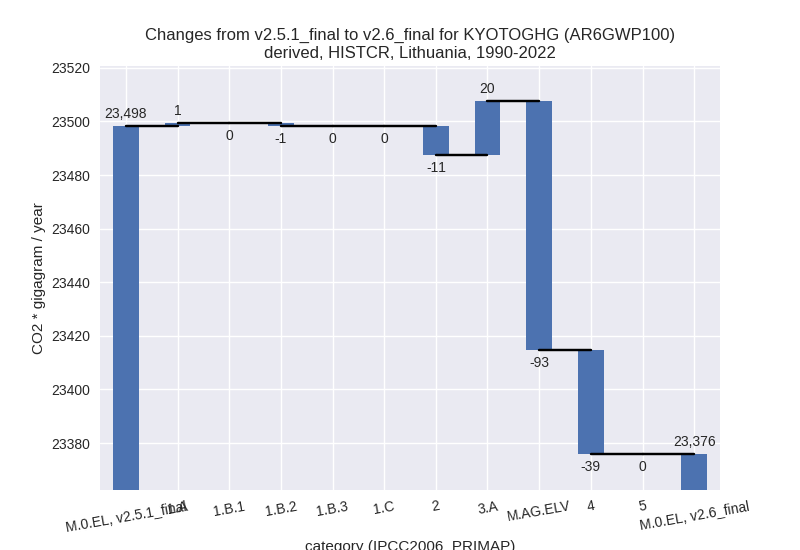
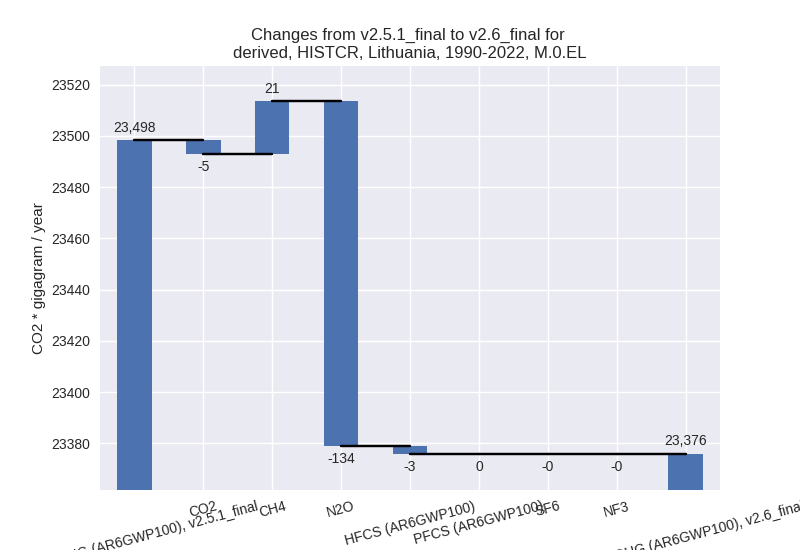
third party scenario
2022
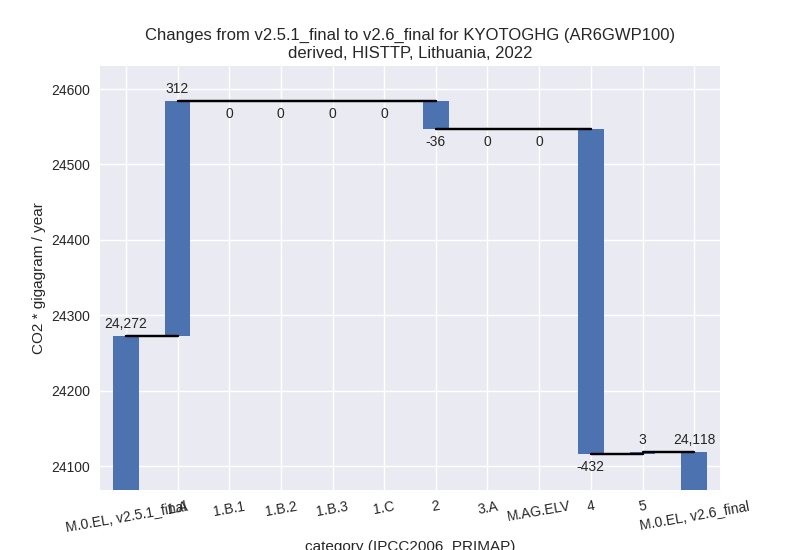

1990-2022
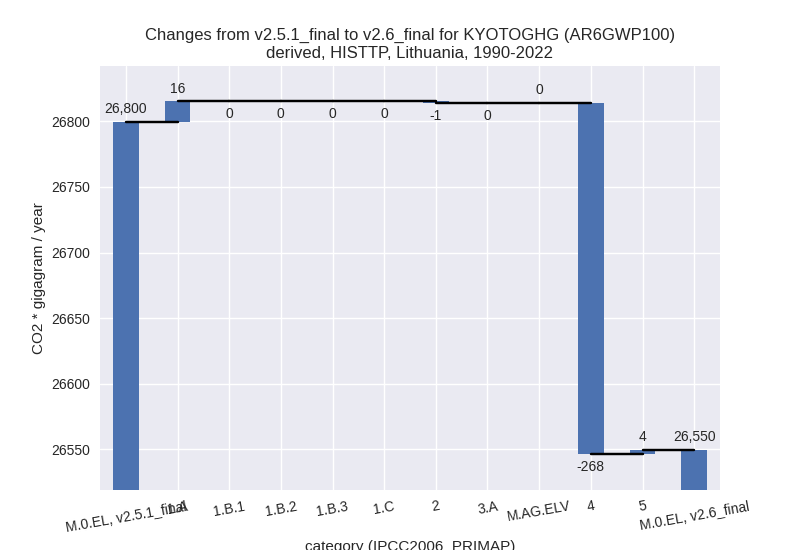
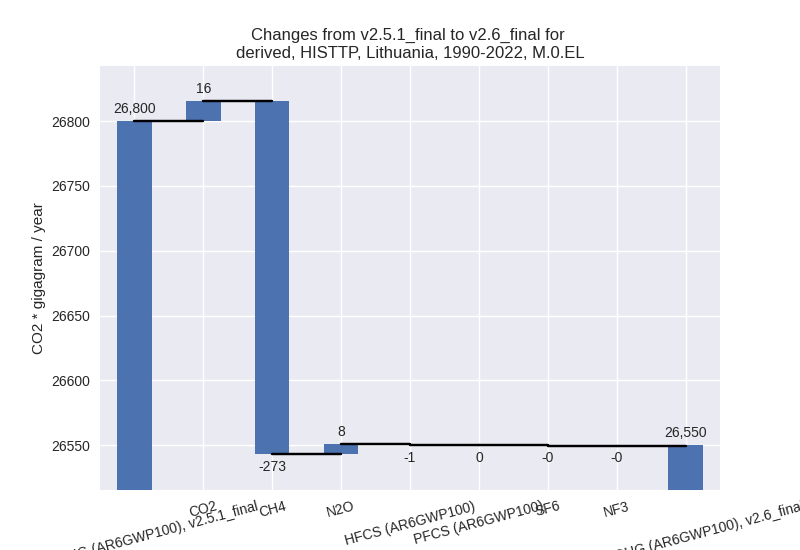
Detailed changes for the scenarios:
country reported scenario (HISTCR):
Most important changes per time frame
For 2022 the following sector-gas combinations have the highest absolute impact on national total KyotoGHG (AR6GWP100) emissions in 2022 (top 5):
- 1: M.AG.ELV, N2O with -359.88 Gg CO2 / year (-15.9%)
- 2: 2, CO2 with -268.65 Gg CO2 / year (-14.0%)
- 3: 1.A, CO2 with 123.59 Gg CO2 / year (1.1%)
- 4: 3.A, CH4 with 114.56 Gg CO2 / year (6.0%)
- 5: 4, CH4 with 109.16 Gg CO2 / year (16.1%)
For 1990-2022 the following sector-gas combinations have the highest absolute impact on national total KyotoGHG (AR6GWP100) emissions in 1990-2022 (top 5):
- 1: M.AG.ELV, N2O with -92.37 Gg CO2 / year (-4.7%)
- 2: 4, N2O with -42.33 Gg CO2 / year (-71.4%)
- 3: 3.A, CH4 with 18.71 Gg CO2 / year (0.7%)
- 4: 2, CO2 with -8.47 Gg CO2 / year (-0.4%)
- 5: 4, CH4 with 3.31 Gg CO2 / year (0.2%)
Changes in the main sectors for aggregate KyotoGHG (AR6GWP100) are
- 1: Total sectoral emissions in 2022 are 11745.45 Gg CO2 / year which is 61.6% of M.0.EL emissions. 2022 Emissions have changed by 0.6% (66.54 Gg CO2 / year). 1990-2022 Emissions have changed by 0.0% (0.03 Gg CO2 / year).
- 2: Total sectoral emissions in 2022 are 2378.54 Gg
CO2 / year which is 12.5% of M.0.EL emissions. 2022 Emissions have
changed by -10.9% (-292.24 Gg CO2 /
year). 1990-2022 Emissions have changed by -0.3% (-10.71 Gg CO2 / year). For 2022 the
changes per gas
are:
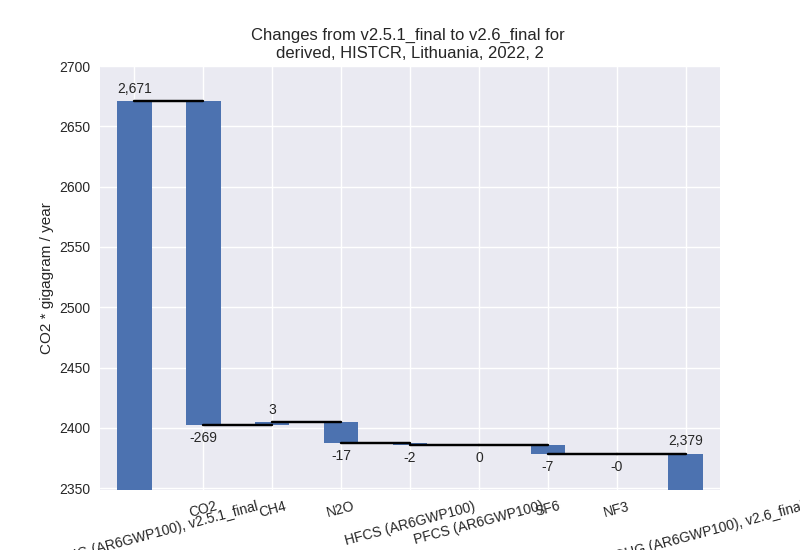
- M.AG: Total sectoral emissions in 2022 are 4109.90
Gg CO2 / year which is 21.6% of M.0.EL emissions. 2022 Emissions have
changed by -5.9% (-258.44 Gg CO2 /
year). 1990-2022 Emissions have changed by -1.5% (-72.69 Gg CO2 / year). For 2022 the
changes per gas
are:
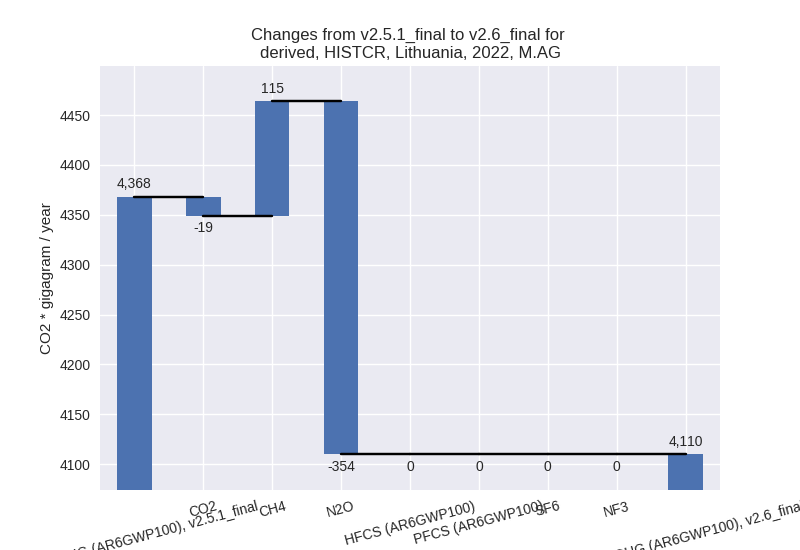
The changes come from the following subsectors:- 3.A: Total sectoral emissions in 2022 are 2109.85
Gg CO2 / year which is 51.3% of category M.AG emissions. 2022 Emissions
have changed by 6.1% (120.51 Gg CO2
/ year). 1990-2022 Emissions have changed by 0.7% (19.92 Gg CO2 / year). For 2022 the
changes per gas
are:
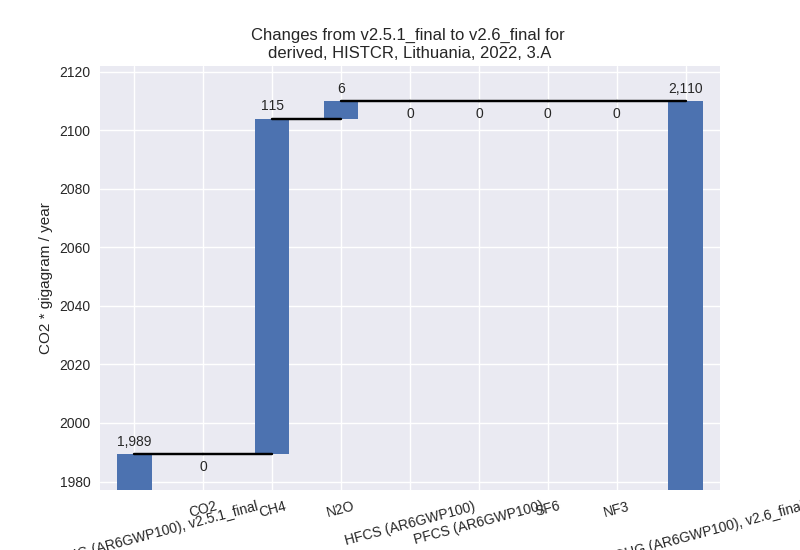
There is no subsector information available in PRIMAP-hist. - M.AG.ELV: Total sectoral emissions in 2022 are
2000.04 Gg CO2 / year which is 48.7% of category M.AG emissions. 2022
Emissions have changed by -15.9%
(-378.95 Gg CO2 / year). 1990-2022 Emissions have changed by -4.5% (-92.61 Gg CO2 / year). For 2022 the
changes per gas
are:

For 1990-2022 the changes per gas are: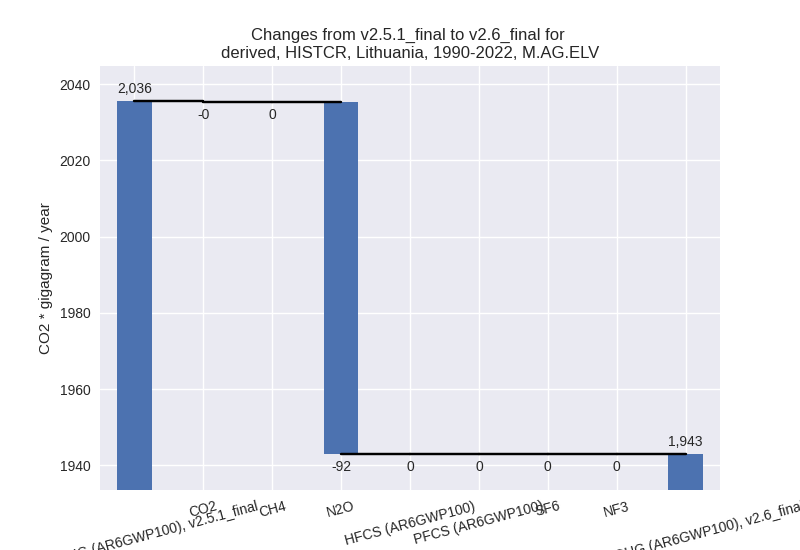
There is no subsector information available in PRIMAP-hist.
- 3.A: Total sectoral emissions in 2022 are 2109.85
Gg CO2 / year which is 51.3% of category M.AG emissions. 2022 Emissions
have changed by 6.1% (120.51 Gg CO2
/ year). 1990-2022 Emissions have changed by 0.7% (19.92 Gg CO2 / year). For 2022 the
changes per gas
are:
- 4: Total sectoral emissions in 2022 are 818.83 Gg
CO2 / year which is 4.3% of M.0.EL emissions. 2022 Emissions have
changed by 9.3% (70.00 Gg CO2 /
year). 1990-2022 Emissions have changed by -2.7% (-39.02 Gg CO2 / year). For 2022 the
changes per gas
are:
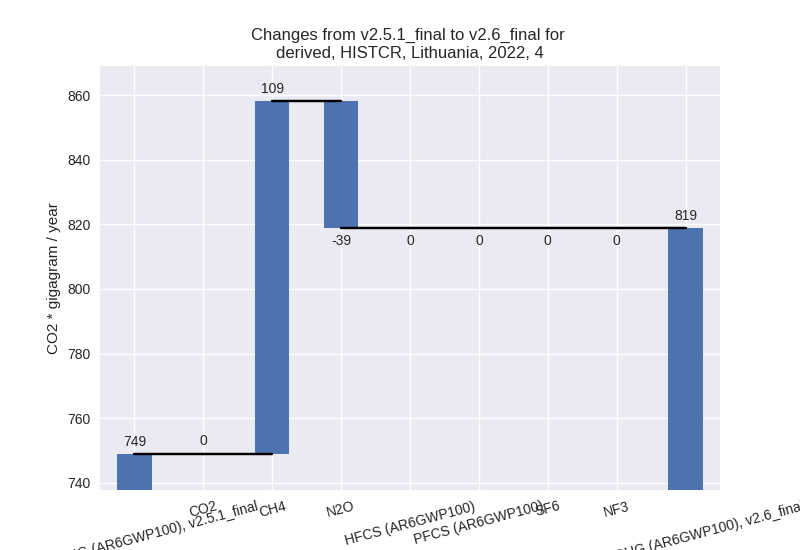
For 1990-2022 the changes per gas are: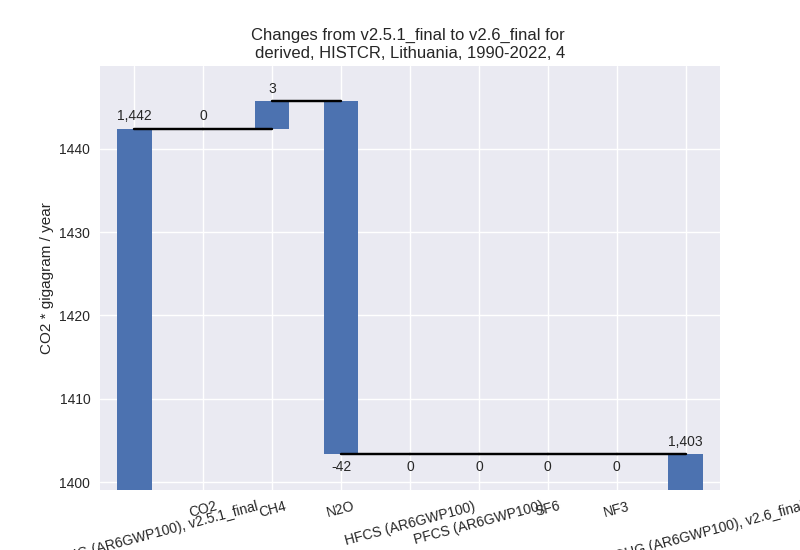
- 5: No data
third party scenario (HISTTP):
Most important changes per time frame
For 2022 the following sector-gas combinations have the highest absolute impact on national total KyotoGHG (AR6GWP100) emissions in 2022 (top 5):
- 1: 4, CH4 with -458.82 Gg CO2 / year (-45.8%)
- 2: 1.A, CO2 with 311.78 Gg CO2 / year (2.5%)
- 3: 2, HFCS (AR6GWP100) with -32.50 Gg CO2 / year (-5.3%)
- 4: 4, N2O with 27.07 Gg CO2 / year (37.6%)
- 5: 2, SF6 with -4.06 Gg CO2 / year (-66.0%)
For 1990-2022 the following sector-gas combinations have the highest absolute impact on national total KyotoGHG (AR6GWP100) emissions in 1990-2022 (top 5):
- 1: 4, CH4 with -272.51 Gg CO2 / year (-19.1%)
- 2: 1.A, CO2 with 15.51 Gg CO2 / year (0.1%)
- 3: 4, N2O with 4.25 Gg CO2 / year (6.4%)
- 4: 5, N2O with 3.55 Gg CO2 / year (4.3%)
- 5: 2, HFCS (AR6GWP100) with -0.98 Gg CO2 / year (-0.4%)
Changes in the main sectors for aggregate KyotoGHG (AR6GWP100) are
- 1: Total sectoral emissions in 2022 are 13130.64 Gg
CO2 / year which is 54.4% of M.0.EL emissions. 2022 Emissions have
changed by 2.4% (311.78 Gg CO2 /
year). 1990-2022 Emissions have changed by 0.1% (15.51 Gg CO2 / year). For 2022 the
changes per gas
are:
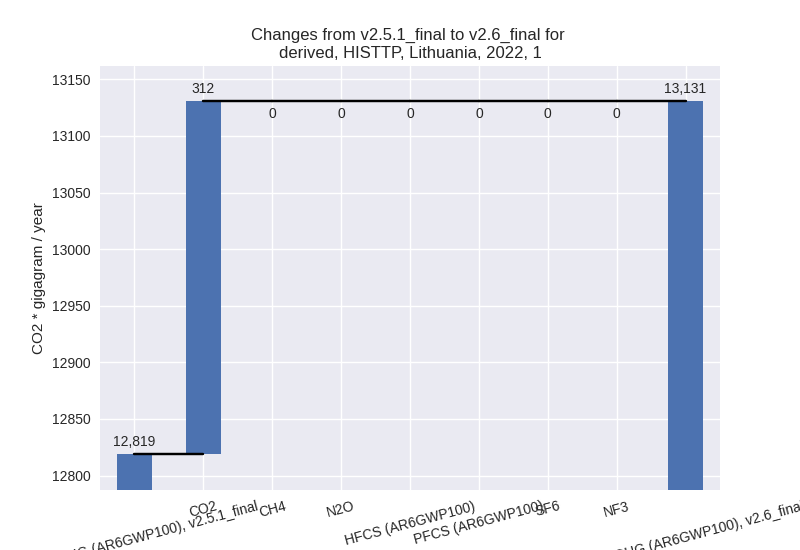
The changes come from the following subsectors:- 1.A: Total sectoral emissions in 2022 are 12977.66
Gg CO2 / year which is 98.8% of category 1 emissions. 2022 Emissions
have changed by 2.5% (311.78 Gg CO2
/ year). 1990-2022 Emissions have changed by 0.1% (15.51 Gg CO2 / year). For 2022 the
changes per gas
are:

There is no subsector information available in PRIMAP-hist. - 1.B.1: Total sectoral emissions in 2022 are 1.35 Gg CO2 / year which is 0.0% of category 1 emissions. 2022 Emissions have changed by 0.0% (0.00 Gg CO2 / year). 1990-2022 Emissions have changed by 0.0% (0.00 Gg CO2 / year).
- 1.B.2: Total sectoral emissions in 2022 are 151.63 Gg CO2 / year which is 1.2% of category 1 emissions. 2022 Emissions have changed by 0.0% (0.00 Gg CO2 / year). 1990-2022 Emissions have changed by 0.0% (0.00 Gg CO2 / year).
- 1.A: Total sectoral emissions in 2022 are 12977.66
Gg CO2 / year which is 98.8% of category 1 emissions. 2022 Emissions
have changed by 2.5% (311.78 Gg CO2
/ year). 1990-2022 Emissions have changed by 0.1% (15.51 Gg CO2 / year). For 2022 the
changes per gas
are:
- 2: Total sectoral emissions in 2022 are 4264.77 Gg CO2 / year which is 17.7% of M.0.EL emissions. 2022 Emissions have changed by -0.8% (-36.40 Gg CO2 / year). 1990-2022 Emissions have changed by -0.0% (-1.00 Gg CO2 / year).
- M.AG: Total sectoral emissions in 2022 are 6023.04 Gg CO2 / year which is 25.0% of M.0.EL emissions. 2022 Emissions have changed by 0.0% (0.00 Gg CO2 / year). 1990-2022 Emissions have changed by 0.0% (0.00 Gg CO2 / year).
- 4: Total sectoral emissions in 2022 are 643.72 Gg
CO2 / year which is 2.7% of M.0.EL emissions. 2022 Emissions have
changed by -40.1% (-431.76 Gg CO2 /
year). 1990-2022 Emissions have changed by -17.9% (-268.21 Gg CO2 / year). For 2022
the changes per gas
are:

For 1990-2022 the changes per gas are: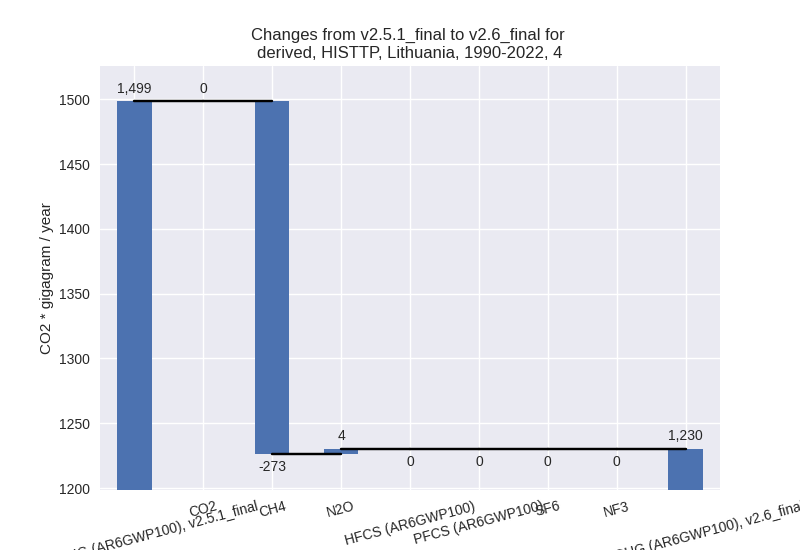
- 5: Total sectoral emissions in 2022 are 56.15 Gg
CO2 / year which is 0.2% of M.0.EL emissions. 2022 Emissions have
changed by 5.0% (2.67 Gg CO2 /
year). 1990-2022 Emissions have changed by 4.3% (3.55 Gg CO2 / year). For 2022 the
changes per gas
are:
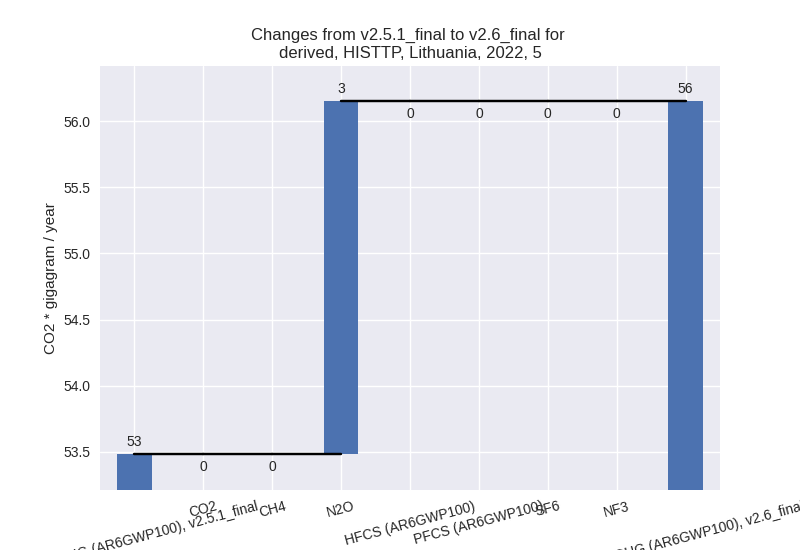
For 1990-2022 the changes per gas are: